
Baby sea turtles running towards the ocean are examples of sea animals with shells.
©Julian Wiskemann/Shutterstock.com
When you think of sea animals with shells, you realize that many different animals in the seas and oceans carry their homes and protection from predators on their backs. The shell-wearing animals are amazing to watch, and it is amazing to discern which animals belong to the same groups of animals.
Crabs, barnacles, and shrimp are all crustaceans, while sea urchins and seahorses are types of fish. The world beneath the ocean holds beauty and exciting animals with and without shells.
1) Echinoids
Echinoids are sea animals with hard shells called tests. On the test, they have knobs that are called tubercles. Most echinoids also have spines, and many of these animals are poisonous.
Predators of echinoids include other species of echinoids, fish, octopuses, and crustaceans.
Sand Dollars
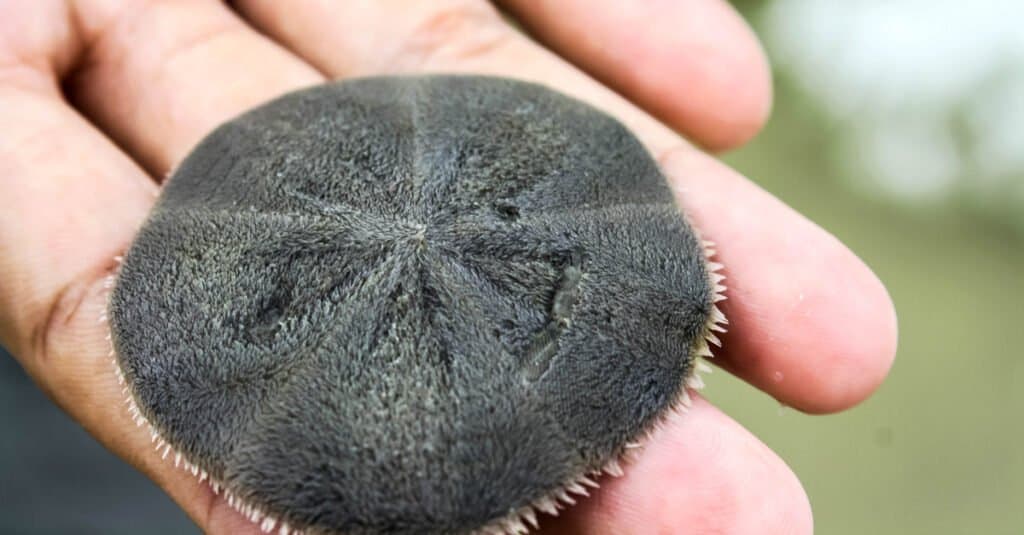
Sand dollars are echinoids that live in the ocean.
©k_lmnop/Shutterstock.com
Most people have seen the white sand dollars collected from beaches. This created the assumption that these animals are white. Sand dollars are dark in color when living, and their exoskeleton is bleached white after their death. Scientists count the rings around their exoskeleton to determine the age of a sand dollar. Like trees, the sand dollar forms a ring on its exoskeleton each year that it is alive.
The holes of a sand dollar are there as pressure relief. Each wave would sweep away the animals without the holes. The spines of the sand dollar are how they eat. They are social animals that prefer to be in a group.
Their hard shells are a method of protection from their predators. Predators of these animals include certain types of eel, flounders, and another echinoid called a large pink sea star.
Sea Urchins
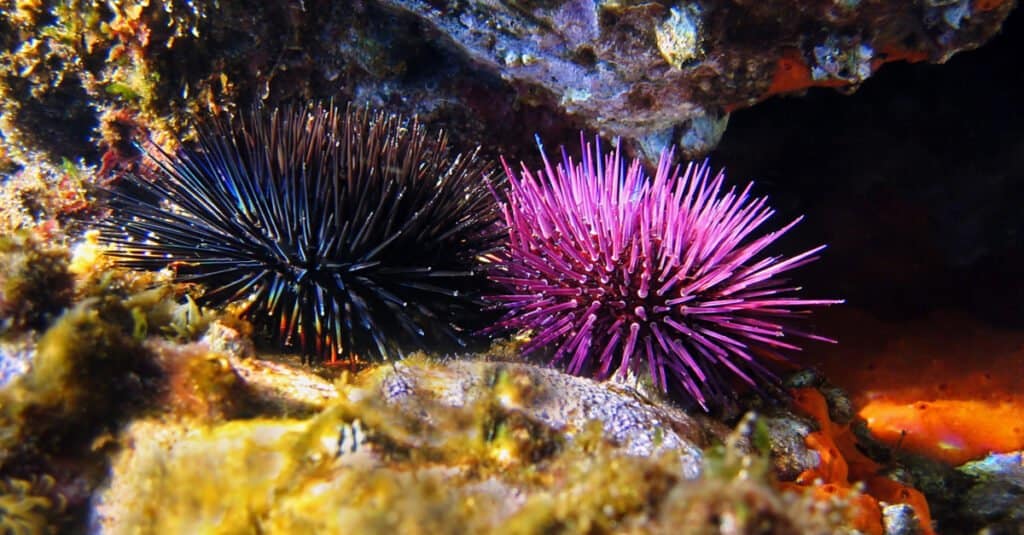
Sea urchins use their spiked shells to protect themselves from predators.
©Damsea/Shutterstock.com
There are 950 types of sea urchins. Sea urchins are omnivores, and they use their shells for protection. These sea animals can injure humans with the toxins and poisons found in their spines. The flowered sea urchin is the most poisonous.
This type of sea animal with shells can live up to 200 years. The majority of them are edible, and they do not have any bones.
2) Fish and Shellfish
Fish are aquatic animals with central spines, fins to breathe with, and bones. Shellfish are also aquatic animals but do not have bones and spines. Instead, they have a shell. It is also interesting that fish can be found in fresh or saltwater, but shellfish live in saltwater only.
Sea Horse or Hippocampus (Horse Caterpillar)
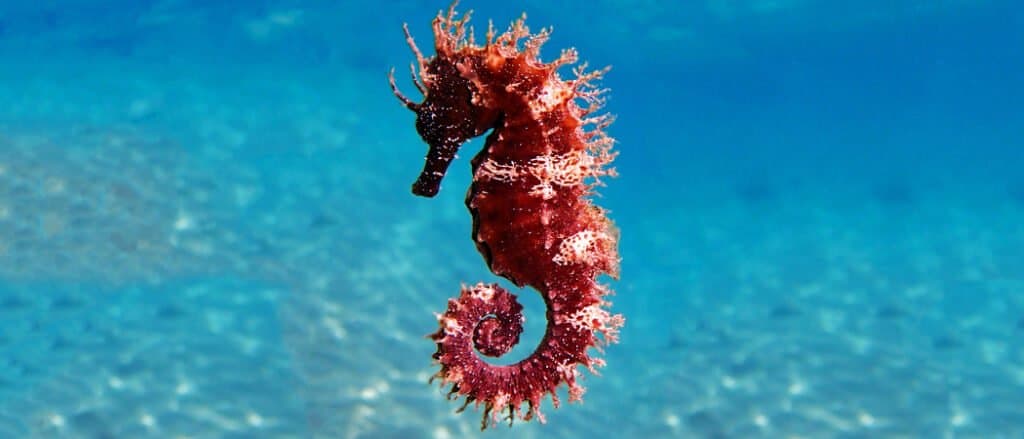
Seahorses are fish that have shells for protection.
©Vojce/Shutterstock.com
These small fish are part of the sea animals with shells. Their shells are for protection from predators. These animals are small, but they have big appetites. Plankton and brine shrimp are their favorite foods, but food moves quickly through their bodies, so they absorb only small amounts of the nutrients. One sea horse can eat 3,000 of the little shrimp each day. Typically, they eat 30 meals each day.
Sea horses use their shells as protection, but they also use their ability to change colors, like a chameleon, to help them hide from predators. Their tails are also used as a defense weapon when they are attacked.
Longhorn Blowfish or Longhorn Cowfish

The longhorn cowfish is a reef fish that has a shell.
©iStock.com/Grigorev_Vladimir
Longhorn cowfish prey on marine invertebrates. The fish blows water jets into the ocean floor’s sand, exposing the invertebrates hiding in the sand. The longhorn blowfish uses its shell as a protection method. They are also extremely poisonous and have horns on either side of their heads that they can use as defense weapons.
Abalone

The shell of the pinto abalone can protect it from some predators but not from environmental changes.
©https://www.flickr.com/photos/onms/27667876484/ – Original / License
An abalone has a flattened spiral shell that is used to protect the muscular foot of the animal. The abalone is an invertebrae that feeds on algae. Abalone does not have red blood like most animals. Their blood is a blue-green color. The blood of an abalone does not have blood clotting factors, so a small injury will result in the animal bleeding to death.
Abalone is edible and considered a delicacy in many cuisines. Oysters and abalone share the ability to take a piece of sand that is irritating them and turn it into a priceless pearl. If a sea star attacks an abalone, the abalone can twist its shell until it dislodges the sea star.
Krill
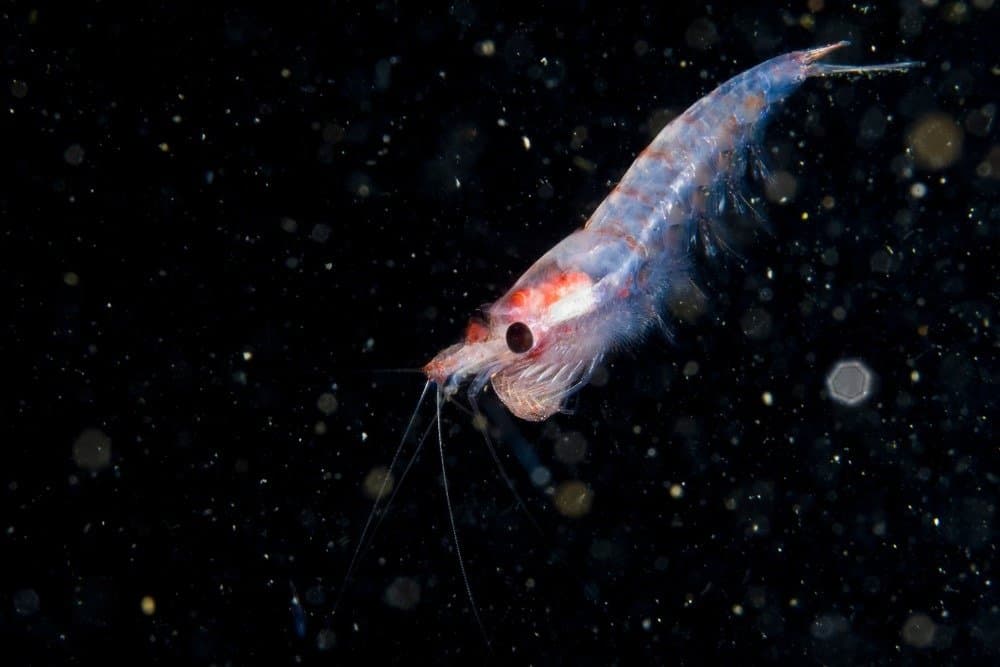
Krill resemble shrimp and use their shells as a means of protection.
©RLS Photo/Shutterstock.com
There are 81 species of krill, and most of them are transparent. They look like shrimp because of their eyes and body shape. Krill gathers together and often forms groups several miles wide and deep. They are the favorite food of many marine animals.
The krill lays up to 10,000 eggs at one time. Ten days after the eggs are laid, the krill will hatch.
3) Mollusks
Chiton
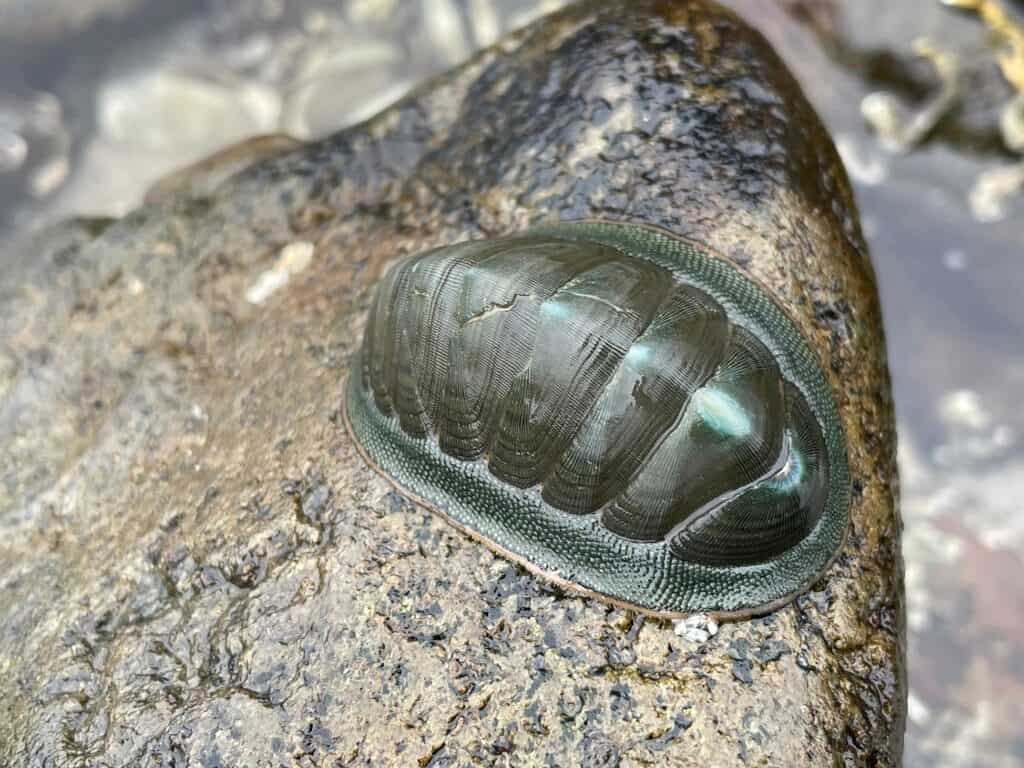
Chitons are an example of a mollusk that lives in the Caribbean.
©Haireena/Shutterstock.com
The shell of a chiton is flexible instead of hard. When a chiton feels threatened, it curls into a ball and uses its shell for protection. There are between 900 and 1,000 different species of chiton. They eat algae and small animals that live in the ocean’s shallow waters, like zooplankton. Its shell is the only protection it has against predators.
Chiton shells are comprised of a series of plates. A girdle wraps around the separate plates and holds them in place. These animals are more abundant in warmer ocean waters. They grow to be about two inches in length.
Nautiluses

A nautilus uses its shell to hide from predators.
©rodho/Shutterstock.com
The nautilus is between six and eight inches when mature. Nautilus has pinhole eyes that allow it to perceive light and dark, but it relies on its other senses, like smell, to navigate and find food. This animal has a hood-like trap door designed into its shell. The nautilus will shut the trap door and become encased completely in its shell to avoid dangerous predators.
A nautilus is a cephalopod-like octopus. The octopus has eight tentacles, and the nautilus has more than 90. Females lay 12 to 18 eggs yearly, which take 12 months to mature and hatch. A nautilus has a lifespan of 12 to 15 years, which is long for a cephalopod.
Limpets
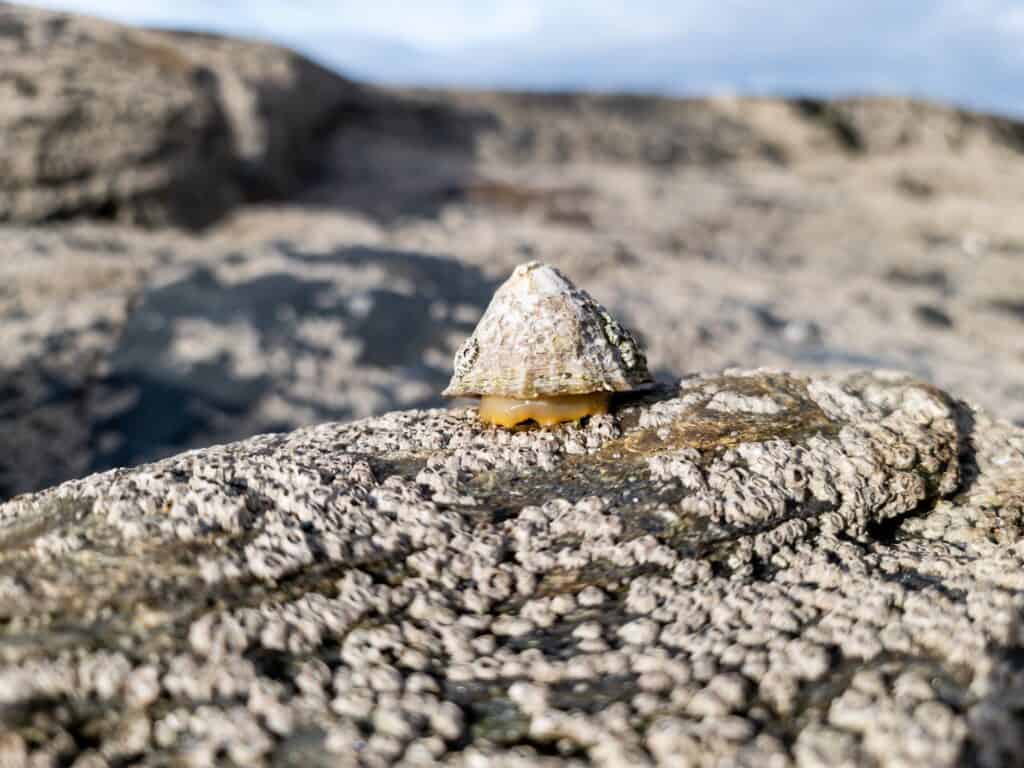
Limpets are sea snails that are active while young and stationary as adults.
©Lukassek/Shutterstock.com
The limpets are homebodies from the sea. When they leave their favorite home base to eat, they return to the same base and position afterward. When they are young, they are active and move around to locate food, but as they mature, they begin to stay in one place and wait for food to come to them.
The shell of the limpet is both a home and a defense against predators. Limpets grow to be two to three inches long, and the female limpet is larger than the male. Lifespans for limpets are up to sixteen years. They prefer to remain underwater because it is easier for them to get around when they are underwater.
Cowry

Sea snails like cowry leave beautiful shells for humans and other animals.
©Klaus Vartzbed/Shutterstock.com
Like other snails, the cowry uses their hard shells as home and defense barriers against predators. These sea animals with shells eat algae, sponges, seaweed, and carrion. They will also eat other gastropods. The shells of the cowries range in color, including patterned, purple, and white shells. Their shells are shaped like eggs and are found near rocky areas on the ocean floor.
The main predators of cowries are other sea snails. Humans also prey on the cowrie because their flesh is edible and their shells are valuable.
Clam
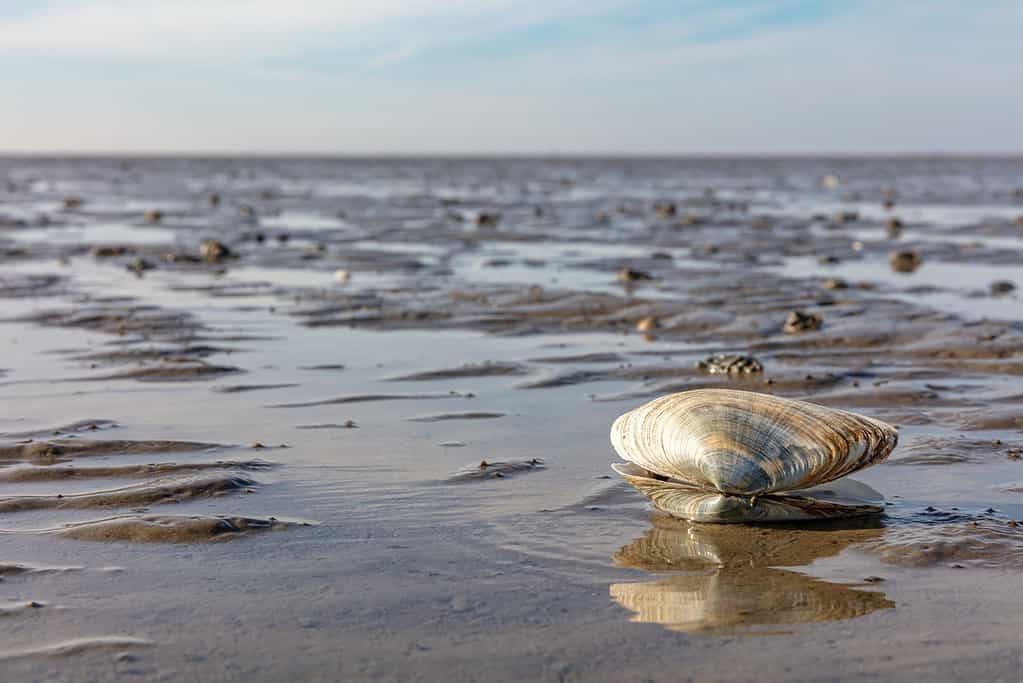
Clams have hinged shells, so they can open the two halves.
©Bjoern Wylezich/Shutterstock.com
The clam is one of the most recognizable sea animals with shells. Clams are edible and included in many types of cuisines around the world. The shell of the clam is a defense mechanism. When the clam is threatened, it can close its shell, making it hard for predators to scoop the living flesh out.
There are 15,000 species of clams around the world. Clams bury themselves in the sand to avoid detection. A clam may have a short life, or evidence shows that a clam may live to be 500 years old. Clams have one foot they press out of their shell to move them along the ocean floor or the beach.
Scallops

The shell of the scallops is made of two parts that are different shapes.
©Gill Copeland/Shutterstock.com
Scallops are unique sea animals with shells because the two halves of their shells are not the same shape. The lower section of the scallop has a bowl-shaped shell, and the upper section of the scallop shell is flat. They detect the most subtle light changes using their 50 to 100 pairs of eyes. The eyes of the scallop appear blue.
When they sense danger, they shut their shells and hide inside. The shell is the only means of defense this bivalve mollusk has. They can swim by rapidly opening and closing their shells. Twenty years is a typical lifespan for this sea animal. They can reproduce at two, but normally, they do not reproduce until they are four. Scallops eat phytoplankton, algae, and other microorganisms.
4) Crustaceans
Crabs
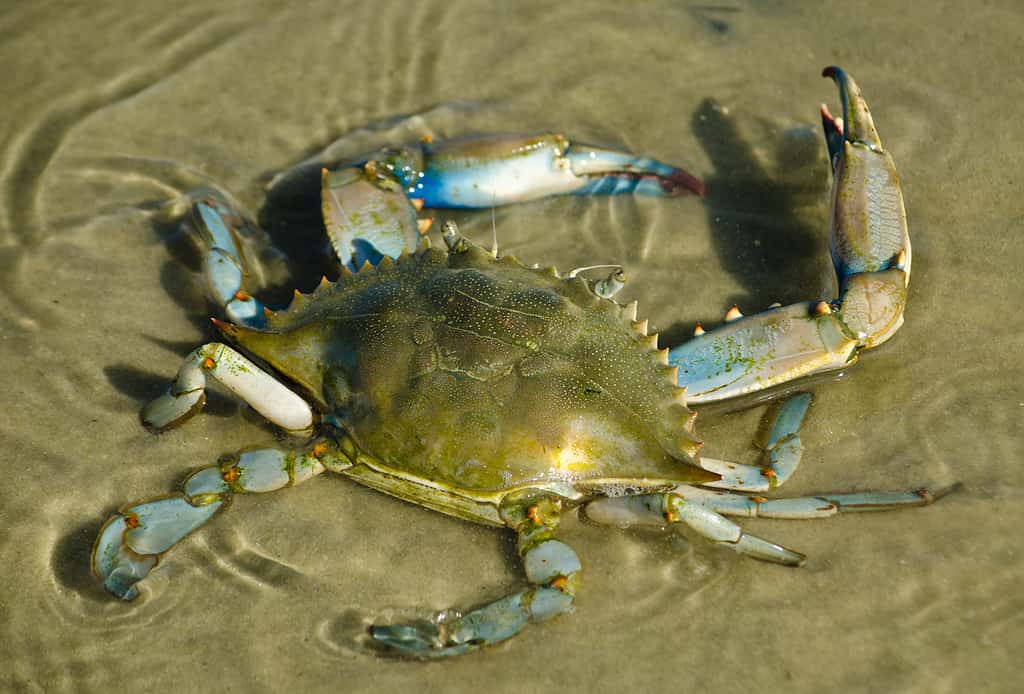
Blue-shelled crabs are just one of the many species of crabs in the world.
©MeliaMuse/iStock via Getty Images
Crabs are one of the sea animals with shells that most people recognize. There are 4,500 crab species, including the blue-shelled crab, the hermit crab, the king crab,, and the Dungeness crab. Crab shells are part of their defense against predators. The animals also have powerful pinschers that they can use in battle or when trying to escape from a predator.
Humans eat some crabs, but some species of crabs are not edible, and other species of crabs are poisonous. Crabs are decapods. This means they have ten legs, but most crabs have eight legs and two claws. If a crab appendage is severed over time, they will grow a new one. Crabs eat a variety of algae, seaweed, worms, fish, and other things from their environment.
Oyster

The shell of an oyster protects the animal from predators.
©David Monniaux / Creative Commons – Original
Oysters live to be 20 years old. The shell of an oyster is calcium-rich and is used to enhance soil in gardens. These animals are capable of changing their sex from male to female. The young oysters are called spats until they are one year old. They breathe through their gills.
An oyster’s only protection against predators is its ability to close its shell and hide inside. These animals filter algae from the sea and keep the water clean. One oyster can filter up to 50 gallons of water each day. Algae is the only food source for this animal.
Lobsters
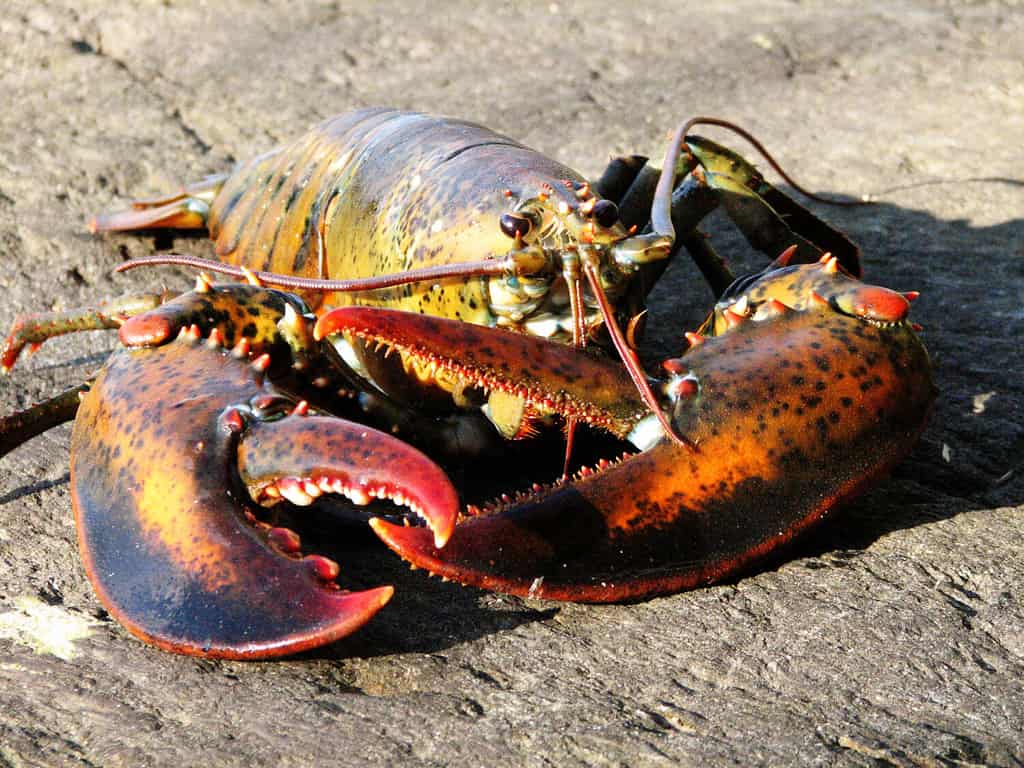
The lobster uses its shell as protection from predators.
©/Shutterstock.com
Lobsters are sea animals with shells that they use to protect them from predators. This sea animal also has claws that can be used to fight or escape a predator. Their claws are two different sizes, and they use them for different things. The largest claw is used to grab things and apply a crushing force. The smaller claw is used to rip or tear their food into pieces.
As lobsters grow, they must shed their shells and grow new ones. This is called molting. During the months the lobster takes to grow a new shell, they are vulnerable to being injured or killed.
Shrimp
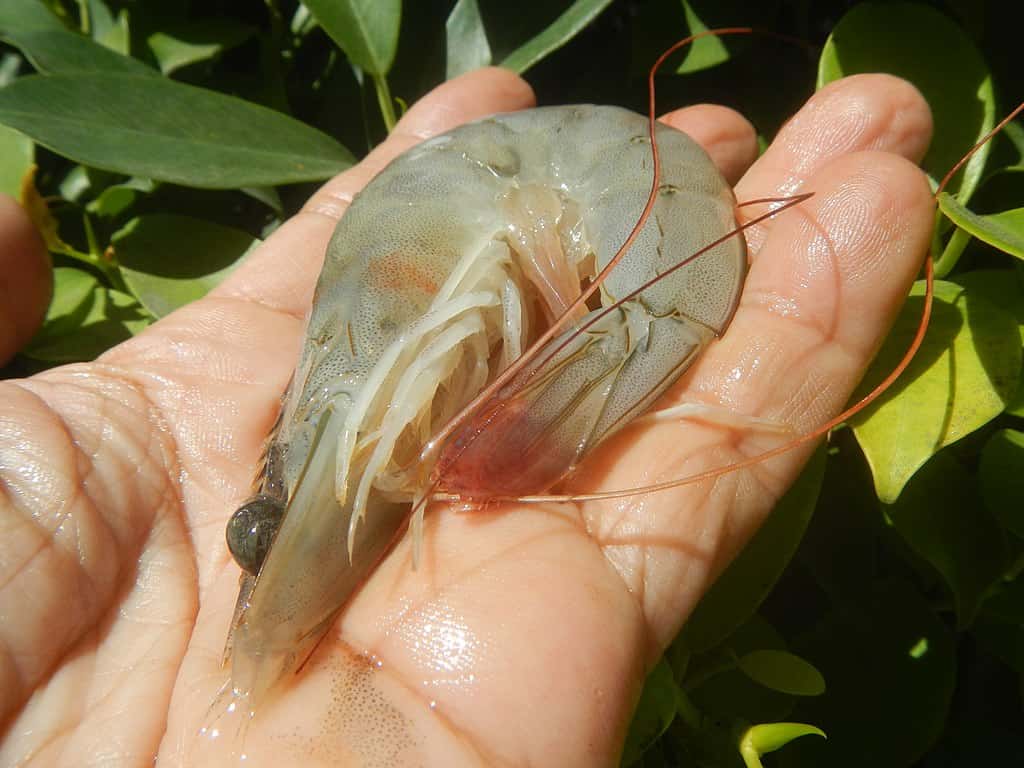
Shrimp shells are essential safety devices for the animals.
©Judgefloro, CC0, via Wikimedia Commons – Original / License
A shrimp is an edible source of protein of vital importance to the ecosystems. Shrimp are a food source for thousands of marine animals and a human food source. These sea animals have pinschers like lobsters or crayfish. Shrimp can snap their pinschers to make loud snapping sounds.
Shrimp are fast swimmers and can avoid some predators by outmaneuvering them in the water. Like most sea animals with shells, shrimp use their shells to protect them from predators. They are omnivores that eat plant and animal matter, and some larger shrimp prey on small fish.
5) Reptiles
Reptiles are cold-blooded animals that lay soft-shelled eggs. Snakes, crocodiles, alligators,s and turtles are reptiles. Bodies of reptiles have scales, which are hard parts covering portions of them. One reptile that is a sea animal with a shell is a unique masterpiece.
Sea Turtles
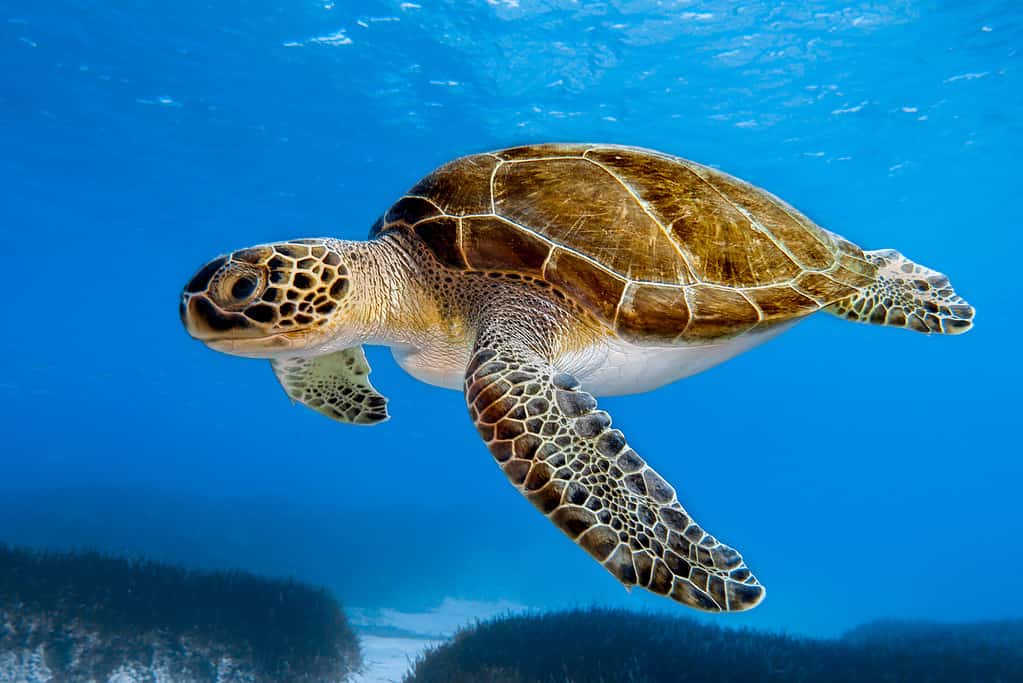
Sea turtle
uses their shells as protection and to help them swim.
©Sakis Lazarides/ via Getty Images
Leatherback sea turtles are one of the seven species of sea turtles. These sea animals with shells use their shells as protection, and the heavy shells help them to swim in the strong ocean currents. Sea turtles are a part of the 100 reptiles that inhabit the ocean waters.
Male sea turtles never leave the water, but females climb onto the sandy beaches to lay their eggs. The lifespan of a sea turtle in the ocean is 50 to 100 years. Their lifespan is longer in captivity because they are protected from danger and polluted ecosystems.
Summary of Sea Animals That Have Shells
| Sea Animal | Type of Animal |
| Sea Urchins | Echinoids |
| Sand Dollars | Echinoids |
| Sea Horse | Fish |
| Longhorn Blowfish | Reef Fish |
| Pinto Abalone | Shellfish |
| Krill | Fish |
| Chiton | Mollusks |
| Nautiluses | Mollusks |
| Limpets | Mollusks |
| Cowry | Mollusks |
| Clam | Molluscs |
| Scallops | Mollusks |
| Crabs | Crustacean |
| Oyster | Crustacean |
| Lobsters | Crustacean |
| Shrimp | Crustacean |
| Sea Turtles | Reptile |
The photo featured at the top of this post is © https://www.flickr.com/photos/onms/27667876484/ – License / Original
Thank you for reading! Have some feedback for us? Contact the AZ Animals editorial team.







